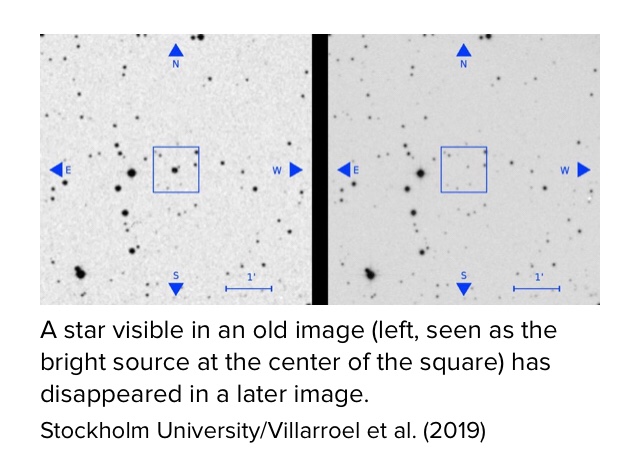
At least 100 stars that were visible in past photos, including one taken in the year 1950, are now missing. Extraterrestrials building structures around these stars to harness more energy is one possible explanation being considered by scientists. Yes, it could be aliens.
On March 16, 1950, astronomers at the US Naval Observatory pointed a telescope roughly in the direction of the constellation Lupus the wolf and took a picture. When scientists look at that same patch of sky today, something is missing, and it could be evidence of something else lurking out there. … “Unless a star directly collapses into a black hole, there is no known physical process by which it could physically vanish,” explains a new study published in the Astronomical Journal and led by Beatriz Villarroel of Stockholm University and Spain’s Instituto de Astrofísica de Canarias. “The implications of finding such objects extend from traditional astrophysics fields to the more exotic searches for evidence of technologically advanced civilizations.”
Read more: CNet
Scientists involved in the VASCO project suggest one possible explanation is that advanced extraterrestrial civilizations might be building megastructures—like Dyson spheres—around these stars to capture their energy, causing them to disappear from view. While this idea is speculative and no direct evidence of aliens has been found yet, the unusual disappearance of these stars is prompting researchers to consider such exotic possibilities alongside traditional astrophysical explanations[1][2].
Here are a few other possible explanations for the missing stars:
– Variable stars or dimming: Some stars naturally vary in brightness or can be obscured by dust clouds, making them appear to vanish temporarily or permanently.
– Data or photographic errors: Differences in image quality, exposure, or processing between old and new photos might cause stars to seem missing.
– Stellar evolution: Some stars might have ended their life cycles, exploding as supernovae or collapsing into black holes, making them no longer visible.
– Interstellar dust or gas clouds: Dust clouds moving between us and the stars can block their light, causing apparent disappearance.
– Gravitational lensing or alignment effects: Changes in the line of sight due to moving objects could affect star visibility.
– Wandering black holes: Wandering or “rogue” black holes—black holes not anchored in a galaxy—could potentially explain some missing stars by moving through space and either consuming stars or disrupting their visibility. Astronomers have recently detected the first confirmed rogue stellar-mass black hole using gravitational microlensing, which bends and magnifies light from background stars as the black hole passes in front[9]. In rare cases, black holes can disrupt or consume individual stars, causing them to disappear or flare briefly in tidal disruption events[2][3]. While wandering black holes could account for some missing stars, the scale of over 100 stars disappearing would require many such black holes or other mechanisms, so this remains one of several possible explanations alongside dust obscuration, stellar evolution, or exotic ideas like extraterrestrial megastructures.
While the alien megastructure hypothesis is exciting, these more conventional explanations are carefully investigated first.
The answer could be stranger still. It may turn out that we live in a universe where entire stars do just vanish when the quantum dice add up right, or this may be evidence that the simulation occasionally takes shortcuts to save data. It will be interesting to watch.
Read More
[1] https://www.reddit.com/r/aliens/comments/1hsgkv6/a_100_stars_or_so_have_disappeared_from_the_night/
[2] https://www.cnet.com/science/missing-stars-could-point-to-alien-civilizations-scientists-say/
[3] https://www.thenewatlantis.com/publications/missing-the-night-sky
[4] https://www.nature.com/articles/s41598-021-92162-7
[5] https://www.skyatnightmagazine.com/space-science/t-coronae-borealis-nova
[6] https://powerhouse.com.au/stories/sky-guide-february-2025
[7] https://www.space.com/news/live/night-sky-for-tonight-what-to-see
[8] https://theskylive.com/guide
[9] https://www.astronomy.com/science/astronomers-detect-first-potential-rogue-black-hole/
[10] https://www.space.com/abell-2261-supermassive-black-hole-missing
[11] https://news.mit.edu/2023/astronomers-detect-example-black-hole-devouring-star-0428
[12] https://www.nasa.gov/centers-and-facilities/jpl/runaway-star-might-explain-black-holes-disappearing-act/